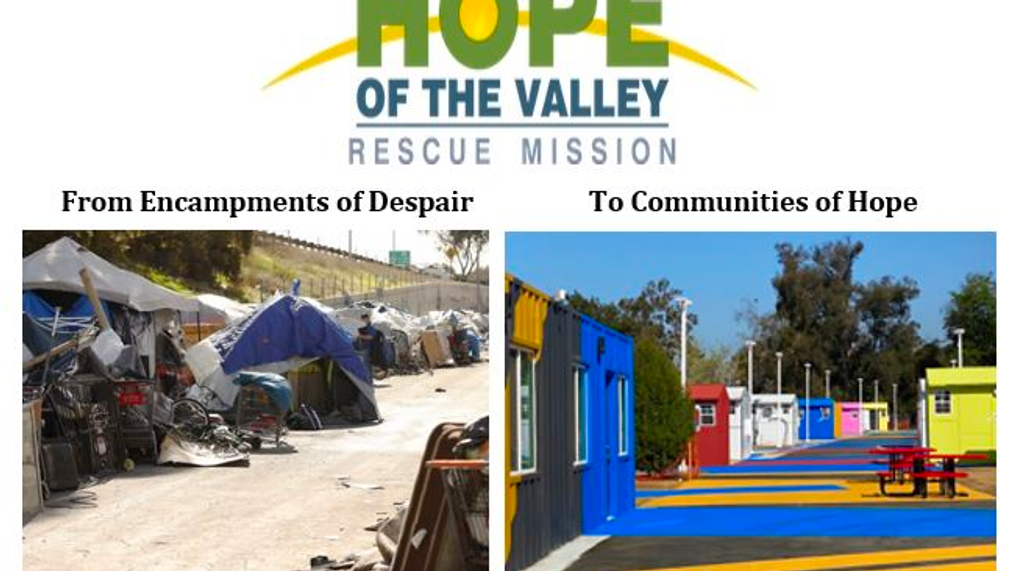Tiny Home Villages for Homelessness
Our newest innovation to serve the homeless is through our Tiny Home Villages. Rather than housing hundreds of people in a dorm setting like the massive shelters downtown, Hope of the Valley is providing “homes” to serve our clients. Now in six locations in the Valley and Highland Park, we are providing over 900 beds each night along with meals, hygiene services, and a full complement of rehabilitation programs to help transition people from homelessness to permanent housing.

What is the primary issue area that your application will impact?
Housing and Homelessness
In which areas of Los Angeles will you be directly working?
San Gabriel Valley
San Fernando Valley
Antelope Valley
In what stage of innovation is this project, program, or initiative?
Applying a proven model or solution to a new issue or sector (e.g., using a job recruiting software or strategy to match clients to supportive housing sites, applying demonstrated strategies from advocating for college affordability to advocating for housing affordability and homelessness, etc.)
What is your understanding of the issue that you are seeking to address?
Hope of the Valley operates 16 shelters with over 1,500 beds nightly. We expect to serve more than 1.6 million meals this year to the hungry and homeless with a full complement of rehabilitation programs including intensive case management, mental health services, substance abuse counseling, medical care, life skill training, job placement, and housing navigation. Hope of the Valley is now one of the largest providers of housing and services to the homeless in California. While our ultimate goal is permanent housing and independence for the homeless, the streets cannot be the waiting room. That is why we are offering temporary, emergency housing through six Tiny Home Villages throughout the valley to take people in now, address the obstacles that are keeping them from self-sufficiency, and then help transition them into a life of hope, purpose, and a place to call home.
Describe the project, program, or initiative this grant will support to address the issue.
Being homeless is one of the most traumatic experiences for anyone. People have not just lost a job or shelter, they’ve lost connection with family, friends, community, and even themselves. Hope of the Valley sees our mission as more than a temporary safety net. We also want to create some sense of normalcy, routine, comfort, community, family, and a place to call home. This is being accomplished through six Tiny Home Villages, providing over 900 beds every night in the Valley for the formerly homeless. Each home is 64 square feet with two beds, heating, air-conditioning, windows, storage, and a locking front door which gives our clients a real sense of independence and security. Residents have access to onsite meals, hygiene services, healthcare, WiFi, mental health care, substance abuse counseling, housing support, job training and placement to start a whole new life! The City of Los Angeles views the homeless crises as their number one priority and they love the Tiny Home concept. In addition to the land and construction, the City provides a stipend of $55 per day, per person we serve. But our actual costs are more which creates a gap in our funding needs and we must fill this through community support and other donations and grants.
Describe how Los Angeles County will be different if your work is successful.
All six of our Tiny Homes Village are providing over 900 beds. The average stay at a Tiny Home is about six months so we have a turn-over up to two times a year for a total of 1,800 people who are being served annually through this entire program. And with so many services we offer in a home and neighborhood setting, this reduces the chances that our clients will wind up back on the street again after they leave our services. As this successful model continues to flourish, we see more and more Tiny Home Villages popping up in other communities throughout Los Angeles County with the full support of community and political leaders. And as these villages grow, we believe it will represent a sizeable bite out of the homeless crises and reduce the number of people who return to their cycle of poverty and homelessness. In short, this unique approach will significantly reduce the homeless population in Los Angeles County in the coming years.
What evidence do you have that this project, program, or initiative is or will be successful, and how will you define and measure success?
It is easy for Hope of the Valley to measure our success by the sheer numbers and participants in our program. Specifically, how many went through our program, left with jobs, and now have more permanent housing. To further measure our impact, Hope of the Valley utilizes the Homeless Management Information System and internal excel spreadsheets to track programmatic data. Our Director of Access and Engagement, Director of Residential Programs, and Director of Crises and Interim Housing track the metrics from each individual department. Our program's leadership team submit monthly data reports to the Director of Strategic Initiatives who tracks and analyzes agency-wide programmatic data to assess for program strengths, areas of improvement, and compliance with our funding source requirements.
Approximately how many people will be impacted by this project, program, or initiative?
Direct Impact: 100
Indirect Impact: 200